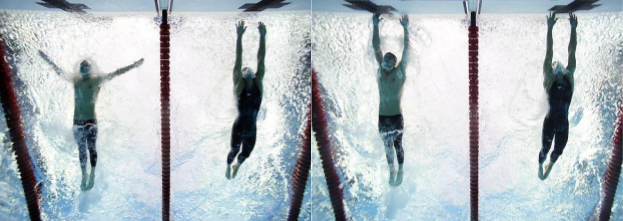Abstract
There’s nothing quite like the thrill of watching a close finish in racing sports such as track and swimming. However, sometimes these finishes are so close that they leave fans, and even referees, wondering who actually completed the race first. To address this ambiguity, the Fully Automatic Timing (FAT) system has been developed. This system combines several precise technologies to determine the finish order and result of every competitor. Its implementation at high-level sporting competitions like the Olympics has been critical in fairly and accurately determining who takes home the gold and who is left with silver.
Introduction
Beijing 2008. Michael Phelps wins the gold medal in the 100-meter butterfly, the seventh of a historical eight golds in a single Olympic Games. He out-touched Milorad Cavic of Serbia by 0.01 seconds, the slimmest of margins in the sport. Such a small difference between the two created a great deal of controversy regarding the validity of the results, as Cavic had been leading for the entire race. How is it possible to determine one’s time in such great detail? And how can anyone be sure that the times are measured fairly and precisely? The ability to do so is thanks to the Fully Automatic Timing (FAT) system, which allows the officials at competitions to precisely determine the order and result of every contestant.
The FAT system differs depending on the sport in which it is used. Most of the sports that include racing and measuring time use line-scan cameras, but other variations include touchpads, which are used in swimming, full-frame video cameras, and photocells [1]. These various timing systems each have their individual merits, but they ultimately work together to ensure that no matter what the competition, athletes are timed in a fair and accurate manner.
Historical Approach to Time Measurement
But what did referees use before implementing these technologies? Stopwatches were the most commonly utilized method of measuring time. Race officials would start their watch as soon as they heard the signal of a gun and stop it when they saw the athlete finish the race. This system, which was in place for many decades, produced imprecise results. One main issue contributing to this lack of precision is reaction time. A referee can react to the sound of the gun much faster than to the sight of the athlete finishing the race, causing the clock to be started faster than it is stopped [3]. Reaction time also depends greatly on the focus of the referee at that exact moment – it can be affected by each individual’s state of mind, especially when fatigue builds from recording the times of many races. The most important factor, though, is that while these trends are similar among all people, the actual difference between reaction times to visual and aural signals varies by individual. This means that the measured times will be impacted by whichever official recorded them [3].
Line-Scan Cameras
Races such as the 2008 men’s 100-meter butterfly happen in every sport. Not too long ago, Bahamian runner Shaunae Miller bested USC’s Allyson Felix in the 400-meter dash at the 2016 Olympic Games in Rio de Janeiro. As the two approached the finish line, Miller dove forward to dramatically win by the slim margin of 0.07 seconds [5]. Many questioned the legitimacy of this action, and whether or not Miller had actually crossed over the line before Felix, who remained running. However, Miller’s claim to gold was solidified due to the line-scan camera system, which is used widely in many different sports, including all track events at high-level competitions.
The line-scan camera is precisely what one would expect it to be: it scans the finish line. The main difference is that the camera does so at an incredibly fast frequency, taking no less than 1,000 pictures a second. Some cameras even reach as many as 10,000 pictures per second [1].
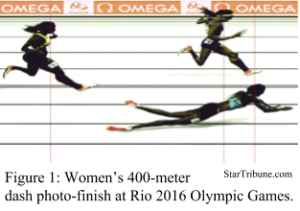
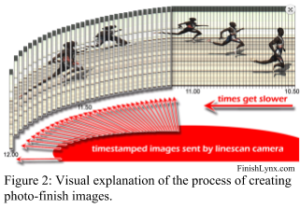
This allows the timekeepers to determine times and order of the competitors with incredible accuracy. Many of us have probably seen a picture of a photo-finish on TV or the Internet after a close race. For those who have not, the photo-finish in Figure 1 (from the Miller vs. Felix race) may seem quite unusual. Still, the viewer can easily see the exact moment that Miller’s torso crosses the finish line, with Felix running behind her by just a fraction of a second. However, this image is not the original shot taken by the line-scan camera. The real pictures taken are actually very narrow, usually showing only a few millimeters of the track [6]. Each of these pictures is then time-stamped and stitched together, one after another, from right to left, producing the complete image of the photo-finish (Fig. 2). The resulting, slightly distorted image is easier to analyze, therefore it gives referees a starting point before they go into more depth to determine the results of the race.
There are a few reasons why the picture taken is so thin. The narrower the picture, the easier it is to tell which point is the finish. Moreover, with the image being so narrow, the errors caused by perspective are minimized. Lastly, the smaller the picture, the faster the cameras can process them and prepare to take another one, which increases the overall accuracy of the system.
Touchpads
Line-scan cameras are the most accurate and reliable FAT systems currently available. However, they cannot be used in sports like swimming, where the finish is based on touch rather than by crossing a line. Swimming requires a wall for the finish to be recorded. Current technology does not enable builders to fashion a wall that is perfectly flat and straight at every point. Taking a narrow picture of a line would not then be an accurate measurement of when each swimmer touches the wall. It also means that even if the pool is officially 50-meters long, some lanes may actually be slightly shorter or longer than others [6]. While the differences are usually incredibly slim, they could be significant if times were to be measured with accuracy to the thousands of a second (as they are in track and field). Therefore, another device was necessary to determine the winner in the Phelps vs. Cavic race and other similar sporting events.
Quite interestingly, the device that helped Phelps win the gold medal originated in the place where he trained prior to the race. The University of Michigan’s emeritus professor of physics, Bill Parkinson, invented the touchpad back in 1957 [2]. At the time, as many as 33 officials were needed on the pool deck, where they would time, judge, and referee the competition. Parkinson’s invention was supposed to lower that number. His first prototype was a rubber pad filled with silicone, with copper pads sewn inside and connected to the timer. His invention was a success, and by 1962 it was being used in all NCAA swimming competitions [2].
But how do touchpads work today? The outside of the touchpad is made out of a non-slippery plastic. Behind the plastic is a metal bar, with holes to allow smooth flow of water and ensure that the pad sticks to the wall [9]. Above the water level, wires are connected to the metal bar. Most importantly, there are touch sensors positioned inside of the touchpad, in between the plastic and metal. Their sensitivity is specially set to ignore water movements and react only to the pressure of a swimmer’s touch [8]. When an appropriate degree of pressure is applied to the touchpad, the entire plastic construction moves, initiating the sensors. A signal is sent through the metal bar and the wires into the timekeeper’s computer, where it is time-stamped and saved. The accuracy of the touchpads is one-hundredth of a second, which is slow enough to neutralize the differences between the lengths of the lanes, but fast enough to provide an accurate tool to measure the finish times and order of athletes.
Full-Frame Video Cameras
However, since the sensitivity of the touchpad is set to ignore the movement of water, in very rare occasions it will fail to record the touch of the swimmer. The rules do not specify the pressure with which the touch must be performed. Was this the case in the Phelps vs. Cavic race? During the race, Cavic finished his final stroke and glided into the wall fairly slowly, arms extended. At the same time, Phelps took an extra stroke and forcefully slammed into the wall. Could Cavic have touched first, but with a pressure too slight to be recorded by his touchpad as occurring before that of Phelps? The Serbian team did, in fact, file an official protest, which meant other, secondary timing systems had to be checked. Usually, the old, manual stopwatch system serves this purpose. However high-level competitions like the Olympics utilize a system called full-frame video cameras.
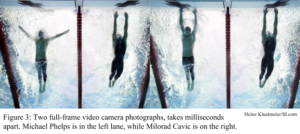
The full-frame video cameras are similar to the line-scan cameras. They take multiple shots of the finish line in a short period of time. However, the picture produced shows the whole frame of the finish, not just a narrow line. This reduces the advantages specified earlier, causing the system to be accurate to only a hundredth of a second [10]. Moreover, it cannot pass zero-control gun tests. In these tests, the starting gun is placed flat on the finish line and fired. The time measured should be exactly zero seconds for the flash to appear [11]. Full-frame video cameras do not pass this test, and therefore are often rejected as an official timekeeping system [1]. However, they are often used as a secondary system, only in situations when the primary system gives ambiguous results. In our case, it provided the definitive answer to the controversy from the Phelps vs. Cavic race. Figure 3 shows two photos – the left pictures the two swimmers moments before the touch. The right photograph demonstrates that Phelps did, in fact, touch the wall while Cavic was just millimeters away from it. These photos ensured that the results measured by the touchpads were correct – Phelps bested Cavic by one one-hundredth of a second.
Photocells, the Future of Sports Timing
This leads one to wonder, though, why a secondary timing system is required to solve such controversies? There must be a way to measure time accurately no matter the situation. The truth is, such technology does exist, in the form of photocells. This timing method is accurate, fast, and inexpensive [4]. It uses light beams that go constantly from a source on one side of the finish line to a receiver on the other side. Once an athlete passes the finish, the beam of light gets broken and the receiver stops receiving any light. It saves the timestamp of this moment and waits for the light to come back. With the speed of light being unattainable by any other physical object, the photocells are the fastest and most accurate timing systems. However, at this moment in time, photocells are unable to differentiate between the identity of the athletes crossing the finish line [7]. Moreover, if two athletes cross the line at nearly the same time, the photocells would take it as one single cross. If someone were to find a solution to these problems, photocells would become the ideal method of timekeeping. For now, photocells are generally only used for immediate measurements of the time of the winner, mainly for television purposes.
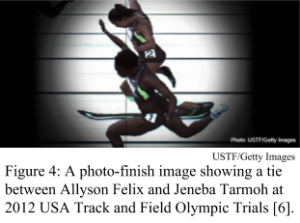
A more accurate timing system is certainly needed. In the women’s 100-meter dash at the 2012 USA Track and Field Olympic Trials, Allyson Felix and Jeneba Tarmoh tied for third place, the last qualifying position for the London Olympics (Fig. 4). The line-scan camera, the most accurate timing system available, failed to determine the winner, as both runners appeared to cross the finish line at the exact same time [6]. The two ended up having a rerun, which could have been avoided if only a more detailed timing system was available.
Conclusion
For athletes, sport is about being the best you can be. They spend their lives training, and when it is time to race, all they think about is their performance. Athletes do not want to worry about whether or not referees will be able to determine the winner without a doubt – they cannot afford to be distracted from the race in any way. However, at the Beijing Olympics, everyone in the stands, as well as all the referees, believed that Cavic had touched the wall first. Without Fully Automatic Timing, the real winner of the race would be left without the gold medal. FAT allows sport to be clear, fair, and unambiguous and lets athletes do what they love: compete.
References
[1] “What is fully automatic timing (FAT) for sports?,” in FinishLynx, 2016. [Online]. Available: http://www.finishlynx.com/about-us/what-is-fully-automatic-timing/. Accessed: Sep. 11, 2016.
[2] L. Porter, “The history of competitive swimming,” LIVESTRONG.COM, 2015. [Online]. Available: http://www.livestrong.com/article/342427-the-history-of-competitive-swimming/. Accessed: Sep. 11, 2016.
[3] J. Shelton and G. P. Kumar, “Comparison between Auditory and Visual Simple Reaction Times,” Neuroscience & Medicine, no. 1, pp. 30–32, Sep. 2010. [Online]. Available: http://file.scirp.org/pdf/NM20100100001_38982209.pdf. Accessed: Sep. 11, 2016.
[4] A. Lovelace, “Overview,”. [Online]. Available: https://learn.adafruit.com/photocells/overview. Accessed: Sep. 11, 2016.
[5] R. Maese, “Shaunae Miller dives to gold over Allyson Felix in women’s 400 meters,” in Washington Post, Washington Post, 2016. [Online]. Available: https://www.washingtonpost.com/sports/olympics/shaunae-miller-dives-to-gold-over-allyson-felix-in-womens-400-meters/2016/08/15/5fc6c0c2-62e8-11e6-96c0-37533479f3f5_story.html. Accessed: Sep. 11, 2016.
[6] J. Merron, “Dead heat in Olympic trial reveals limitations in finish-line tech,” in Play, ReadWrite, 2012. [Online]. Available: http://readwrite.com/2012/06/27/dead-heat-in-olympic-trial-reveals-limitations-in-finish-line-tech/. Accessed: Sep. 11, 2016.
[7] “Critical things you need to know about timing system accuracy,” in Speed & Agility Training and Testing, Fusion Sport, 2016. [Online]. Available: https://www.fusionsport.com/blog/critical-things-need-know-timing-system-accuracy/. Accessed: Sep. 11, 2016.
[8] “Measuring and Certifying Competition Pools,” in USA Swimming, 2014. [Online]. Available: http://www.usaswimming.org/_Rainbow/Documents/9148f9e7-cbca-4cf2-975a-f8f2bb27f664/USA%20Swimming%20Pool%20Measurement%20Information%20March%202014.pdf. Accessed: Sep. 11, 2016.
[9] A. Vetter, “Touchpad TP for Swimming,” in ALGE-TIMING. [Online]. Available: https://alge-timing.com/alge/SWIM-TP-E.htm. Accessed: Sep. 11, 2016.
[10] “Compare to FinishLynx timing,” in Eagle Eye Pro Timing. [Online]. Available: http://www.eagleeyedv.com/FinishLynx_s/570.htm. Accessed: Sep. 11, 2016.
[11] “For athletes – Zero gun test,” in USA Masters. [Online]. Available: http://www.usatfmasters.org/zerogunlynx.htm. Accessed: Sep. 11, 2016.

